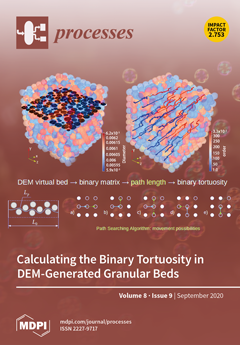Most dyes used in the textile industry are chemically stable and poorly biodegradable, therefore, they are persistent in the environment and difficult to degrade by conventional methods. An alternative treatment for this kind of substance is heterogeneous photocatalysis using TiO
2, so,
[...] Read more.
Most dyes used in the textile industry are chemically stable and poorly biodegradable, therefore, they are persistent in the environment and difficult to degrade by conventional methods. An alternative treatment for this kind of substance is heterogeneous photocatalysis using TiO
2, so, in this work, it is proposed to degrade Direct Blue 1 (DB1) using microparticulate TiO
2 irradiated with e-beam at three different doses: 5, 10 and 20 kGy (J/kg). The DB1 degradation was implemented in a batch reactor (DB1 initial concentration = 50 mg L
−1, pH 2.5, TiO
2 concentration = 200 mg L
−1). We have demonstrated that the photocatalytic power of TiO
2, when irradiated with e-beam (5, 10, 20 kGy), varies slightly, with minor effects on photodegradation performance. However, the dose of 10 kGy showed a slightly better result, according to the DB1 photodegradation rate constant. Adsorption process was not affected by irradiation; its isotherm was fitted to Freundlich’s mathematical model. The DB1 photodegradation rate constants, after one hour of treatment, were: 0.0661 and 0.0742 min
−1 for irradiated (10 kGy) and nonirradiated TiO
2, respectively. The degradation rate constant has an increase of 12.3% for irradiated TiO
2. Finally, there was no evidence of mineralization in the degradation process after 60 min of treatment. According to the results, the irradiation of microparticulate TiO
2 with e-beam (10 kGy) slightly improves the photodegradation rate constant of DB1.
Full article





